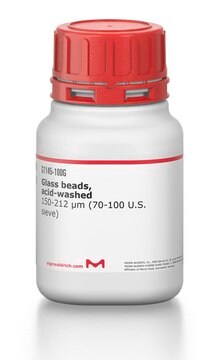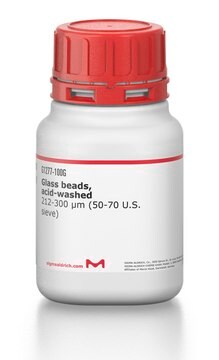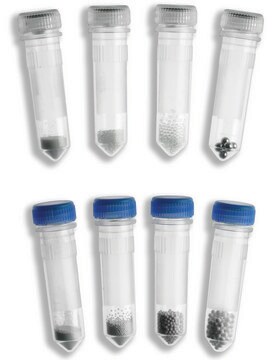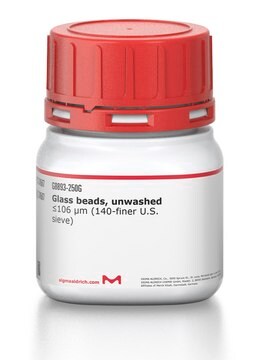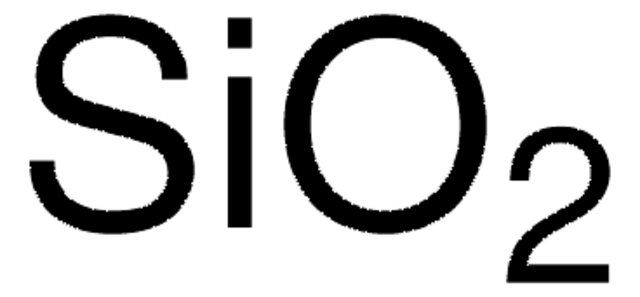G1152
Glass beads, acid-washed
710-1,180 μm (16-25 U.S. sieve)
Synonym(e):
Glass Beads
Anmeldenzur Ansicht organisationsspezifischer und vertraglich vereinbarter Preise
Alle Fotos(3)
About This Item
UNSPSC-Code:
41102422
NACRES:
NB.22
Empfohlene Produkte
Partikelgröße
710-1,180 μm (16-25 U.S. sieve)
Anwendung
Acid-washed glass beads have been used:
- in the extraction of proteins from antigen-expressing transgenic lines of Nicotiana tabacum L.
- to extract DNA of Candida albicans from human and murine blood samples
- to measure lipid yield from microalga C.homosphaera by adopting different methods of cell disruption methods
Lagerklassenschlüssel
11 - Combustible Solids
WGK
nwg
Flammpunkt (°F)
Not applicable
Flammpunkt (°C)
Not applicable
Persönliche Schutzausrüstung
Eyeshields, Gloves, type N95 (US)
Analysenzertifikate (COA)
Suchen Sie nach Analysenzertifikate (COA), indem Sie die Lot-/Chargennummer des Produkts eingeben. Lot- und Chargennummern sind auf dem Produktetikett hinter den Wörtern ‘Lot’ oder ‘Batch’ (Lot oder Charge) zu finden.
Besitzen Sie dieses Produkt bereits?
In der Dokumentenbibliothek finden Sie die Dokumentation zu den Produkten, die Sie kürzlich erworben haben.
Kunden haben sich ebenfalls angesehen
Novel strategy for microalgae cell disruption and wet lipid extraction by employing electro-Fenton process with sacrificial steel anode
Wanniarachchige P, et al.
Bioresource Technology (2022)
Continued expression of plant-made vaccines following long-term cryopreservation of antigen-expressing tobacco cell cultures
Van E J and Keen P.
In Vitro Cellular & Developmental Biology. Plant, 45(6), 750-757 (2009)
Katarina Damjanovic et al.
Microbial ecology, 79(3), 706-719 (2019-08-23)
Coral-associated bacteria are critical for the well-being of their host and may play essential roles during ontogeny, as suggested by the vertical transmission of some bacteria in brooding corals. Bacterial acquisition patterns in broadcast spawners remain uncertain, as 16S rRNA
Sarah L Sokol et al.
eLife, 7 (2018-05-23)
Most eukaryotic parasites are obligately heteroxenous, requiring sequential infection of different host species in order to survive. Toxoplasma gondii is a rare exception to this rule, having a uniquely facultative heteroxenous life cycle. To understand the origins of this phenomenon
Déborah Tribouillard-Tanvier et al.
PloS one, 3(5), e2174-e2174 (2008-05-15)
6-Aminophenanthridine (6AP) and Guanabenz (GA, a drug currently in use for the treatment of hypertension) were isolated as antiprion drugs using a yeast-based assay. These structurally unrelated molecules are also active against mammalian prion in several cell-based assays and in
Unser Team von Wissenschaftlern verfügt über Erfahrung in allen Forschungsbereichen einschließlich Life Science, Materialwissenschaften, chemischer Synthese, Chromatographie, Analytik und vielen mehr..
Setzen Sie sich mit dem technischen Dienst in Verbindung.
